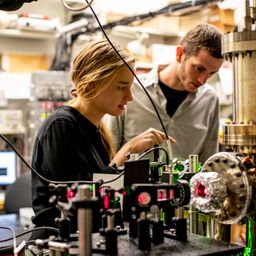To what potential should you charge a 1.00 μF capacitor to store 1.70 J of energy?
Problem 1
A charge of $28.0 \mathrm{nC}$ is placed in a uniform electric field that is directed vertically upwards and that has a magnitude of $4.00 \times 10^{4} \mathrm{~N} / \mathrm{C} .$ What work is done by the electric strength when the charge moves (a) $0.450 \mathrm{~k}$ to the right; (b) $0.670 \mathrm{~g}$ upward;
(c) $2.sixty \mathrm{~m}$
at an angle of $45.0^{\circ}$ downward from the horizontal?

Katie K.
Numerade Educator
Problem 2
Two very big charged parallel metallic plates are $10.0 \mathrm{~cm}$ apart and produce a uniform electric field of $2.80 \times 10^{6} \mathrm{~N} / \mathrm{C}$ between them. A proton is fired perpendicular to these plates with an initial speed of $five.twenty \mathrm{~km} / \mathrm{south},$ starting at the centre of the negative plate and going toward the positive plate. How much work has the electrical field done on this proton past the time it reaches the positive plate?

Kai C.
Princeton University
Trouble 3
How far from a $-seven.20 \mu \mathrm{C}$ point charge must a $+2.30 \mu \mathrm{C}$ betoken accuse exist placed in club for the electric potential energy of the pair of charges to exist $-0.400 \mathrm{~J}$ ? (Take the energy to be zero when the charges are infinitely far apart.)

Katie Thou.
Numerade Educator
Problem four
A signal charge $q_{1}=+two.40 \mu \mathrm{C}$ is held stationary at the origin. A 2d point charge $q_{2}=-4.30 \mu \mathrm{C}$ moves from the indicate $x=0.150 \mathrm{~1000}, \quad y=0,$ to the indicate $x=0.250 \mathrm{~m}, \quad y=0.250 \mathrm{~m}$
(a) What is the alter in potential energy of the pair of charges?
(b) How much piece of work is done by the electrical force on $q_{2} ?$

Vishal 1000.
Numerade Educator
Problem 5
Two stationary signal charges of $+three.00 \mathrm{nC}$ and $+2.00 \mathrm{nC}$ are separated by a distance of $50.0 \mathrm{~cm} .$ An electron is released from rest at a indicate midway between the charges and moves forth the line connecting them. What is the electric potential energy for the electron when information technology is (a) at the midpoint and
(b) $x.0 \mathrm{~cm}$ from the $+three.00 \mathrm{nC}$ charge?

Katie One thousand.
Numerade Educator
Trouble 6
A gear up of bespeak charges is held in place at the vertices of an equilateral triangle of side $x.0 \mathrm{~cm},$ equally shown in Figure $18.34 .$ (a) What is the electrical potential free energy of the $-iii.00 \mathrm{nC}$ charge? (b) What would be the maximum kinetic
energy of the $-3.00 \mathrm{nC}$ charge if it were released from rest in the friction-
less void of outer space? (Assume the other charges are held in place.) (c) When will this maximum kinetic energy exist achieved, merely following the release or after a very long time?

Vishal K.
Numerade Educator
Problem 7
Three equal $1.20 \mu \mathrm{C}$ point charges are placed at the corners of an equilateral triangle whose sides are $0.500 \mathrm{~thou}$ long. What is the potential energy of the system? (Take as zilch the potential free energy of the iii charges when they are infinitely far apart.)

Katie Chiliad.
Numerade Educator
Problem 8
When ii point charges are a distance $R$ apart, their potential energy is $-2.0 \mathrm{~J}$. How far (in terms of $R$ ) should they be from each other so that their potential energy is $-6.0 \mathrm{~J} ?$

Kai C.
Princeton University
Problem 9
Two large metallic parallel plates carry contrary charges of equal magnitude. They are separated past $45.0 \mathrm{~mm},$ and the potential departure between them is $360 \mathrm{~V}$. (a) What is the magnitude of the electric field (assumed to be compatible) in the region between the plates? (b) What is the magnitude of the forcefulness this field exerts on a particle with charge $+2.40 \mathrm{nC} ?$

Katie M.
Numerade Educator
Problem 10
A potential difference of $4.75 \mathrm{kV}$ is established between parallel plates in air. If the air becomes ionized (and hence electrically conducting) when the electric field exceeds $3.00 \times ten^{6} \mathrm{~V} / \mathrm{thousand},$ what is the minimum separation the plates can take without ionizing the air?

Kai C.
Princeton Academy
Problem eleven
Neurons are the basic units of the ner-
vous system. They contain long tubular structures called
axons that propagate electrical signals away from the ends of the neurons. The
axon contains a solution of potassium ions $\mathrm{M}^{+}$ and large negative organic ions. The axon membrane prevents the big ions from leaking out, but the smaller $\mathrm{K}^{+}$ ions are able to penetrate the membrane to some caste. (See Effigy $18.35 .)$ This leaves an excess of negative charge on the inner surface of the axon membrane and an excess of positive accuse on the outer surface, resulting in a potential difference across the membrane that prevents further $\mathrm{Thousand}^{+}$ ions from leaking out. Measurements show that this potential divergence is typically about $lxx \mathrm{mV}$. The thickness of the axon membrane itself varies from about 5 to $10 \mathrm{nm}$, and so we'll use an boilerplate of $seven.5 \mathrm{nm}$. We can model the membrane as a large sheet having equal and opposite accuse densities on its faces. (a) Find the electric field inside the axon membrane, assuming (non too realistically) that it is filled with air. Which style does it point, into or out of the axon? (b) Which is at a higher potential, the inside surface or the outside surface of the axon membrane?

Vishal G.
Numerade Educator
Problem 12
Electrical sensitivity of sharks. Certain sharks tin detect an electric field every bit weak every bit $i.0 \mu \mathrm{V} / \mathrm{m}$. To grasp how weak this field is, if you wanted to produce it between two parallel metal plates past connecting an ordinary $1.5 \mathrm{~V}$ AA bombardment beyond these plates, how far apart would the plates have to be?

Vishal G.
Numerade Educator
Trouble 13
A particle with a accuse of $+4.20 \mathrm{nC}$ is in a uniform electrical field $\vec{E}$ directed in the negative $x$ direction. Information technology is released from rest, and after it has moved $6.00 \mathrm{~cm},$ its kinetic energy is plant to be $+1.fifty \times 10^{-6} \mathrm{~J}$. (a) What work was done by the electric force?
(b) What was the change in electric potential over the distance that the charge moved? (c) What is the magnitude of $\overrightarrow{\boldsymbol{E}} ?$ (d) What was the change in potential energy of the accuse?

Vishal Grand.
Numerade Educator
Problem 14
Two very large metallic parallel plates are $20.0 \mathrm{~cm}$ apart and carry equal, only contrary, surface accuse densities. Figure 18.36 shows a graph of the potential, relative to the negative plate, as a role of $10$. For this instance, $x$ is the distance from the inner surface of the negative plate, measured perpendicular to the plates, and points from the negative plate toward the positive plate. Notice the electric field between the plates.

Katie M.
Numerade Educator
Problem 15
A uniform electric field has magnitude $E$ and is directed in the negative $x$ direction. The potential departure between point $a$ (at $x=0.threescore \mathrm{~thou}$ ) and point $b$ (at $x=0.90 \mathrm{~m}$ ) is $240 \mathrm{~5}$.
(a) Which indicate, $a$ or $b$, is at the higher potential? (b) Calculate the value of $E$.
(c) A negative point charge $q=-0.200 \mu \mathrm{C}$ is moved from $b$ to $a$. Calculate the work done on the betoken charge by the electric field.

John-Paul M.
Numerade Educator
Problem 16
A signal charge is sitting at the origin. The electric potential at the position $x=iii \mathrm{~one thousand}, y=five \mathrm{~m}$ is $-50 \mathrm{mV} .$ What are the magnitude and sign of the charge?

Vishal G.
Numerade Educator
Problem 17
(a) An electron is to exist accelerated from $iii.00 \times 10^{half dozen} \mathrm{~yard} / \mathrm{due south}$ to $eight.00 \times x^{six} \mathrm{~m} / \mathrm{due south} .$ Through what potential difference must the electron pass to accomplish this?
(b) Through what potential deviation must the electron pass if information technology is to be slowed from $viii.00 \times 10^{6} \mathrm{~thou} / \mathrm{s}$ to a halt?

Kai C.
Princeton Academy
Problem eighteen
A pocket-sized particle has accuse $-5.00 \mu \mathrm{C}$ and mass $2.00 \times 10^{-iv} \mathrm{~kg}$. It moves from point $A$, where the electrical potential is $V_{A}=+200 \mathrm{~V}$, to bespeak $B$, where the electric potential is $V_{B}=+800 \mathrm{~V}$. The electric force is the only force acting on the particle. The particle has speed $v.00 \mathrm{~m} / \mathrm{s}$ at bespeak $A .$ What is its speed at point $B ?$ Is it moving faster or slower at $B$ than at $A$ ? Explain.

Katie M.
Numerade Educator
Trouble 19
Two point charges $q_{1}=+2.twoscore \mathrm{nC}$ and $q_{2}=-6.50 \mathrm{nC}$ are $0.100 \mathrm{~g}$ apart. Point $A$ is midway between them; point $B$ is $0.080 \mathrm{~1000}$ from $q_{1}$ and $0.060 \mathrm{~1000}$
from $q_{2}$. (See Figure $\left.18.37 .\right)$ Take the electric potential to exist zero at infinity. Find (a) the potential at point $A ;$ (b) the potential at betoken $B ;$ (c) the work done by the electric field on a charge of $2.50 \mathrm{nC}$ that travels from
bespeak $B$ to point $A$.

Vishal G.
Numerade Educator
Problem twenty
A bespeak charge $Q=+4.60 \mu \mathrm{C}$ is held fixed at the origin. A 2nd point charge $q=+1.20 \mu \mathrm{C}$ with mass of $2.fourscore \times 10^{-4} \mathrm{~kg}$ is placed on the $ten$ axis, $0.250 \mathrm{~g}$ from the origin. (a) What is the electric potential energy $U$ of the pair of charges? (Have $U$ to be zero when the charges accept infinite separation.)
(b) The second point charge is released from residuum. What is its speed when its distance from the origin is (i) $0.500 \mathrm{~m} ;$ (2) $5.00 \mathrm{~m} ;$ (three) $l.0 \mathrm{~thou} ?$

Katie M.
Numerade Educator
Problem 21
Two protons are released from residue when they are $0.750 \mathrm{nm}$ apart. (a) What is the maximum speed they volition reach? When does this speed occur?
(b) What is the maximum acceleration they will achieve? When does this acceleration occur?

Kai C.
Princeton Academy
Problem 22
X-ray tube. An X-ray tube is an evacuated glass tube that produces electrons at ane end and then accelerates them to very high speeds past the time they achieve the other terminate. The dispatch is accomplished using an electrical field. The high-speed electrons striking a metal target at the other stop, and the violence of the collision converts their kinetic free energy into high-energy light rays, normally known as 10-rays. (a) Through what potential difference should electrons be accelerated so that their speed is $i.0 \%$ of the speed of calorie-free when they hit the target? (b) What potential difference would be needed to give protons the same kinetic energy equally the electrons?
(c) What speed would this potential divergence give to protons? Express your answer in $\mathrm{m} / \mathrm{s}$ and as a percent of the speed of light.

Vishal Chiliad.
Numerade Educator
Problem 23
A parallel-plate capacitor having plates $6.0 \mathrm{~cm}$ apart is connected across the terminals of a $12 \mathrm{~V}$ battery. (a) Being every bit quantitative as y'all can, depict the location and shape of the equipotential surface that is at a potential of $+6.0 \mathrm{~V}$ relative to the potential of the negative plate. Avert the edges of the plates. (b) Practice the same for the equipotential surface that is at $+ii.0 \mathrm{~V}$ relative to the negative plate.
(c) What is the potential gradient betwixt the plates?

Kai C.
Princeton University
Problem 24
Two very large metallic parallel plates that are $25 \mathrm{~cm}$ apart, oriented perpendicular to a canvas of paper, are connected across the terminals of a $50.0 \mathrm{~5}$ bombardment. (a) Draw to scale the lines where the equipotential surfaces due to these plates intersect the paper. limit your drawing to the region betwixt the plates, avoiding their edges, and depict the lines for surfaces that are $10.0 \mathrm{~5}$ apart, starting at the lowpotential plate. (b) These surfaces are separated every bit in potential. Are they also separated as in distance? (c) In words, describe the shape and orientation of the surfaces you merely found.

Vishal G.
Numerade Educator
Problem 25
(a) $\mathrm{A}+v.00 \mathrm{pC}$ charge is located on a sheet of newspaper. (a) Draw to calibration the curves where the equipotential surfaces due to these charges intersect the paper. Show merely the surfaces that have a potential (relative to infinity) of $1.00 \mathrm{~5}, 2.00 \mathrm{~5}, 3.00 \mathrm{~V}, iv.00 \mathrm{~V},$ and $5.00 \mathrm{~V}$. (b) The surfaces are separated equally in potential. Are they as well separated every bit in distance? (c) In words, describe the shape and orientation of the surfaces you just found.

Rashmi Due south.
Numerade Educator
Trouble 26
$\mathrm{A}+1.l \mu \mathrm{C}$ indicate charge is sitting at the origin. (a) What is the radial distance between the 500 V equipotential surface and the $1000 \mathrm{~Five}$ surface? (b) What is the distance between the $1000 \mathrm{~V}$ surface and the $1500 \mathrm{~V}$ surface?
(c) Explain why the answers to (a) and
(b) are non the same.

Vishal G.
Numerade Educator
Trouble 27
A dipole is located on a sheet of paper. (a) In the airplane of that paper, carefully sketch the electric field lines for this dipole.
(b) Use your field lines in part (a) to sketch the equipotential curves where the equipotential surfaces intersect the paper.

Katie M.
Numerade Educator
Trouble 28
(a) You discover that if yous place charges of $\pm one.25 \mu \mathrm{C}$ on two separated metal objects, the potential difference between them is $xi.three \mathrm{~V}$. What is their capacitance?
(b) A capacitor has a capacitance of $7.28 \mu \mathrm{F}$. What amount of excess charge must be placed on each of its plates to brand the potential difference between the plates equal to $25.0 \mathrm{~5} ?$

Kai C.
Princeton University
Problem 29
The plates of a parallel-plate capacitor are $3.28 \mathrm{~mm}$ autonomously, and each has an surface area of $12.two \mathrm{~cm}^{2}$. Each plate carries a accuse of magnitude $four.35 \times 10^{-8} \mathrm{C}$. The plates are in vacuum.
(a) What is the capacitance? (b) What is the potential difference between the plates?
(c) What is the magnitude of the electric field between the plates?

Katie G.
Numerade Educator
Problem 30
The plates of a parallel-plate capacitor are $2.50 \mathrm{~mm}$ apart, and each carries a charge of magnitude $fourscore.0 \mathrm{nC}$. The plates are in vacuum. The electrical field between the plates has a magnitude of $4.00 \times 10^{6} \mathrm{~Five} / \mathrm{yard}$.
(a) What is the potential difference between the plates? (b) What is the area of each plate? (c) What is the capacitance?

Ze-Han L.
Numerade Educator
Trouble 31
A parallel-plate air capacitor has a capacitance of $500.0 \mathrm{pF}$ and a charge of magnitude $0.200 \mu \mathrm{C}$ on each plate. The plates are $0.600 \mathrm{~mm}$ apart. (a) What is the potential difference between the plates? (b) What is the area of each plate? (c) What is the electric-field magnitude between the plates?
(d) What is the surface accuse density on each plate?

Katie Grand.
Numerade Educator
Problem 32
Suppose you lot were to design a $1 \mathrm{~F}$ parallel-plate capacitor that has a plate separation of $0.01 \mathrm{~mm}$. (a) What would be the expanse of each plate? (b) Assuming that the plates are foursquare, what would be the length of a side? (c) Would such a capacitor be practical?

Vishal Thousand.
Numerade Educator
Trouble 33
A $x.0 \mu \mathrm{F}$ parallel-plate capacitor with circular plates is connected to a $12.0 \mathrm{~V}$ bombardment. (a) What is the accuse on each plate?
(b) How much charge would be on the plates if their separation were doubled while the capacitor remained connected to the battery? (c) How much charge would be on the plates if the capacitor were continued to the $12.0 \mathrm{~V}$ battery after the radius of each plate was doubled without changing their separation?

Ze-Han L.
Numerade Educator
Problem 34
A $10.0 \mu \mathrm{F}$ parallel-plate capacitor is connected to a $12.0 \mathrm{~Five}$ battery. After the capacitor is fully charged, the bombardment is disconnected without loss of whatever of the accuse on the plates. (a) A voltmeter is connected across the ii plates without discharging them. What does it read? (b) What would the voltmeter read if (i) the plate separation was doubled; (ii) the radius of each plate was doubled, only the separation between the plates was unchanged?

Vishal Grand.
Numerade Educator
Problem 35
You make a capacitor by cutting the 15.0 -cm-diameter bottoms out of two aluminum pie plates, separating them past $iii.50 \mathrm{~mm}$, and connecting them across a $6.00 \mathrm{~V}$ bombardment. (a) What's the capacitance of your capacitor? (b) If y'all disconnect the battery and carve up the plates to a distance of $3.50 \mathrm{~cm}$ without discharging them, what will be the potential deviation betwixt them?

Vishal Thou.
Numerade Educator
Problem 36
A $5.00 \mathrm{pF}$ parallel-plate air-filled capacitor with circular plates is to exist used in a circuit in which it will exist subjected to potentials of up to $1.00 \times 10^{2} \mathrm{~Five}$. The electric field betwixt the plates is to exist no greater than $i.00 \times 10^{four} \mathrm{~N} / \mathrm{C}$. Equally a budding electrical engineer for Alive-Wire Electronics, your tasks are to (a) design the capacitor by finding what its physical dimensions and separation must be and
(b) find the maximum charge these plates tin agree.

Kai C.
Princeton University
Problem 37
A disk-shaped parallel-plate capacitor has a capacitance $C$. In terms of $C,$ what would the capacitance be if the radius of each plate were increased by a factor of $3 ?$

Vishal 1000.
Numerade Educator
Trouble 38
A parallel-plate capacitor $C$ is charged upward to a potential $V_{0}$ with a charge of magnitude $Q_{0}$ on each plate. It is so disconnected from the battery, and the plates are pulled autonomously to twice their original separation. (a) What is the new capacitance in terms of $C ?$ (b) How much charge is at present on the plates in terms of $Q_{0} ?$ (c) What is the potential deviation across the plates in terms of $V_{0} ?$

Kai C.
Princeton Academy
Problem 39
For the system of capacitors shown in Figure $xviii.38,$ find the equivalent capacitance (a) between $b$ and $c,$ (b) between $a$ and $c .$

Katie One thousand.
Numerade Educator
Problem 40
Electrical eels and electric fish generate large potential differences that are used to stun enemies and prey. These potentials are produced past cells that each can generate $0.ten \mathrm{~V}$. We tin can plausibly model such cells every bit charged capacitors.
(a) How should these cells exist continued (in series or in parallel) to produce a full potential of more $0.ten \mathrm{~V} ?$ (b) Using the connection in part
(a), how many cells must exist connected together to produce the $500 \mathrm{~V}$ surge of the electric eel?

Ze-Han L.
Numerade Educator
Problem 41
In Effigy $xviii.39, \quad C_{1}=6.00 \mu \mathrm{F}, \quad C_{ii}=3.00 \mu \mathrm{F}, \quad$ and $C_{iii}=five.00 \mu \mathrm{F} . \quad$ The $\quad$ capaci-
tor network is continued to an practical potential $V_{a b}$. Later the charges on the capacitors have reached their final values, the charge on $C_{2}$ is $xl.0 \mu \mathrm{C}$.
(a) What are the charges on capacitors $C_{1}$ and $C_{iii} ?$ (b) What is the applied voltage $V_{a b} ?$

Vishal One thousand.
Numerade Educator
Trouble 42
Yous are working on an electronics project that requires a variety of capacitors, simply yous have but v capacitors bachelor, each with a capacitance of $100 \mathrm{nF}$. (a) What is the maximum capacitance that you tin produce with these 5 capacitors? (b) What is the minimum capacitance, other than zero, that yous tin produce?

Vishal G.
Numerade Educator
Problem 43
In Effigy $18.39, C_{1}=3.00 \mu \mathrm{F}$ and $V_{a b}=120 \mathrm{~V}$. The charge on capacitor $C_{one}$ is $150 \mu \mathrm{C}$. Calculate the voltage across the other 2 capacitors.

Katie Thousand.
Numerade Educator
Problem 44
A $four.00 \mu \mathrm{F}$ and a $6.00 \mu \mathrm{F}$ capacitor are wired in parallel, and this combination is connected across a $48.0 \mathrm{~V}$ potential divergence. Calculate (a) the accuse on each capacitor and (b) the potential departure across each of them.

Vishal Grand.
Numerade Educator
Problem 45
In the circuit shown in Figure $xviii.40,$ the potential difference across $a b$ is $+24.0 \mathrm{~V} .$ Calculate
(a) the accuse on each capacitor and
(b) the potential difference across each capacitor.

Katie K.
Numerade Educator
Problem 46
In Figure 18.41 , each capacitor has $C=iv.00 \mu \mathrm{F}$ and $V_{a b}=+28.0 \mathrm{~V} . \quad$ Calculate
(a) the charge on each capacitor and (b) the potential divergence across each capacitor.

Kai C.
Princeton University
Problem 47
Effigy 18.42 shows a system of four capacitors, where the potential divergence across $a b$ is $50.0 \mathrm{~V}$. (a) Notice the equivalent capacitance of this organization between $a$ and $b$. (b) How much charge is stored by this combination of capacitors? (c) How much charge is stored in each of the $10.0 \mu \mathrm{F}$ and the $ix.0 \mu \mathrm{F}$ capacitors?

Katie M.
Numerade Educator
Problem 48
For the system of capacitors shown in Figure eighteen.43 , a potential deviation of $25 \mathrm{~Five}$ is maintained across $a b$. (a) What is the equivalent capacitance of this system betwixt $a$ and $b ?$ (b) How much charge is stored by this organisation? (c) How much charge does the $6.5 \mathrm{nF}$ capacitor store? (d) What is the potential difference across the $7.5 \mathrm{nF}$ capacitor?

Khoobchandra A.
Numerade Educator
Problem 49
How much charge does a $12 \mathrm{~V}$ battery have to supply to fully charge a $2.five \mu \mathrm{F}$ capacitor and a $5.0 \mu \mathrm{F}$ capacitor when they're (a) in parallel, (b) in series? (c) How much energy does the bombardment take to supply in each case?

Katie Grand.
Numerade Educator
Problem 50
A $5.80 \mu \mathrm{F}$ parallel-plate air capacitor has a plate separation of $5.00 \mathrm{~mm}$ and is charged to a potential difference of $400 \mathrm{~V}$. Calculate the energy density in the region betwixt the plates, in units of $\mathrm{J} / \mathrm{grand}^{iii}$.

Ze-Han L.
Numerade Educator
Problem 51
(a) How much charge does a bombardment have to supply to a $5.0 \mu \mathrm{F}$ capacitor to create a potential difference of $1.5 \mathrm{~V}$ beyond its plates? How much energy is stored in the capacitor in this case? (b) How much accuse would the battery take to supply to store $1.0 \mathrm{~J}$ of free energy in the capacitor? What would be the potential across the capacitor in that case?

Katie 1000.
Numerade Educator
Problem 52
In the text, it was shown that the energy stored in a capacitor $C$ charged to a potential $V$ is $U=\frac{one}{2} Q 5 .$ Show that this energy can also exist expressed equally (a) $U=Q^{2} / ii C$ and
(b) $U=\frac{one}{ii} C Five^{2}$.

Kai C.
Princeton University
Trouble 53
A parallel-plate vacuum capacitor has $8.38 \mathrm{~J}$ of energy stored in it. The separation between the plates is $2.30 \mathrm{~mm} .$ If the separation is decreased to $1.xv \mathrm{~mm},$ what is the free energy stored (a) if the capacitor is asunder from the potential source so the charge on the plates remains abiding, and (b) if the capacitor remains continued to the potential source so the potential difference betwixt the plates remains constant?

Katie M.
Numerade Educator
Problem 54
A $v.00 \mathrm{nF}$ parallel-plate capacitor contains $25.0 \mu \mathrm{J}$ of stored energy. (a) What is the potential difference across the capacitor?
(b) By how many volts would you accept to increase this potential difference in guild for the capacitor to store $l.0 \mu \mathrm{J}$ of potential energy?

Vishal K.
Numerade Educator
Trouble 55
For the capacitor network shown in Figure $eighteen.44,$ the potential departure across $a b$ is 36 V. Notice (a) the full charge stored in this network, (b) the charge on each capacitor, (c) the full free energy stored in the network, (d) the free energy stored in each capacitor, and (eastward) the potential difference across each capacitor.

Vishal M.
Numerade Educator
Trouble 56
For the capacitor network shown in Figure $eighteen.45,$ the potential difference beyond $a b$ is $220 \mathrm{~V}$. Find (a) the full charge stored in this network, (b) the accuse on each capacitor, (c) the total energy stored in the network,
(d) the energy stored in each capacitor, and (e) the potential departure across each capacitor.

Vishal Thou.
Numerade Educator
Trouble 57
For the capacitor network shown in Figure $18.46,$ the potential deviation across $a b$ is $12.0 \mathrm{~5}$. Find (a) the total energy stored in this network and (b) the energy stored in the $iv.80 \mu \mathrm{F}$ capacitor.

Kai C.
Princeton Academy
Trouble 58
A parallel-plate air capacitor has a capacitance of $920 \mathrm{pF}$. The charge on each plate is $2.55 \mu \mathrm{C}$. (a) What is the potential deviation between the plates? (b) If the accuse is kept constant, what will be the potential divergence between the plates if the separation is doubled? (c) How much work is required to double the separation?

Katie M.
Numerade Educator
Trouble 59
Prison cell membranes. Prison cell membranes (the walled enclosure around a prison cell) are typically about $7.5 \mathrm{nm}$ thick. They are partially permeable to allow charged material to pass in and out, equally needed. Equal but opposite accuse densities build up on the within and outside faces of such a membrane, and these charges prevent boosted charges from passing through the cell wall. We can model a cell membrane
as a parallel-plate capacitor, with the membrane itself containing proteins embedded in an organic fabric to give the membrane a dielectric constant of virtually
x. (Run across Figure $xviii.47 .)$ (a) What is the capacitance per foursquare centimeter of such a cell wall? (b) In its normal resting state, a cell has a potential difference of $85 \mathrm{mV}$ across its membrane. What is the electrical field inside this membrane?

Sheh Lit C.
University of Washington
Problem lx
A parallel-plate capacitor is to exist constructed by using, as a dielectric, safe with a dielectric constant of 3.20 and a dielectric strength of $20.0 \mathrm{MV} / \mathrm{m}$. The capacitor is to accept a capacitance of $1.50 \mathrm{nF}$ and must be able to withstand a maximum potential deviation of $4.00 \mathrm{kV}$. What is the minimum area the plates of this capacitor can have?

Kai C.
Princeton Academy
Problem 61
$\mathrm{A} 12.5 \mu \mathrm{F}$ capacitor is continued to a ability supply that keeps a constant potential divergence of $24.0 \mathrm{~Five}$ across the plates. A piece of material having a dielectric abiding of three.75 is placed between the plates, completely filling the space betwixt them. (a) How much energy is stored in the capacitor before and after the dielectric is inserted? (b) By how much did the energy modify during the insertion? Did it increase or decrease?

Ze-Han L.
Numerade Educator
Problem 62
The paper dielectric in a newspaper-and-foil capacitor is $0.0800 \mathrm{~mm}$ thick. Its dielectric constant is $2.50,$ and its dielectric force is $50.0 \mathrm{MV} / \mathrm{thousand} .$ Assume that the geometry is that of a parallel-plate capacitor, with the metal foil serving as the plates. (a) What expanse of each plate is required for a $0.200 \mu \mathrm{F}$ capacitor? (b) If the electric field in the paper is not to exceed one-half the dielectric strength, what is the maximum potential divergence that can be applied across the capacitor?

Kai C.
Princeton University
Trouble 63
A constant potential difference of $12 \mathrm{~V}$ is maintained between the terminals of a $0.25 \mu \mathrm{F},$ parallel-plate air capacitor. (a) A sheet of Mylar is inserted between the plates of the capacitor, completely filling the space between the plates. When this is done, how much additional accuse flows onto the positive plate of the capacitor (run into Table 18.1 )? (b) What is the full induced charge on either face of the Mylar sheet? (c) What result does the Mylar canvas have on the electric field between the plates? Explicate how yous tin can reconcile this with the increase in charge on the plates, which acts to increment the electrical field.

Katie Grand.
Numerade Educator
Problem 64
(a) If a spherical raindrop of radius $0.650 \mathrm{~mm}$ carries a charge of $-one.xx \mathrm{pC}$ uniformly distributed over its volume, what is the potential at its surface? (Take the potential to exist goose egg at an infinite distance from the raindrop.) (b) Two identical raindrops, each with radius and charge specified in part (a), collide and merge into one larger raindrop. What is the radius of this larger drib, and what is the potential at its surface, if its charge is uniformly distributed over its volume?

Kai C.
Princeton Academy
Problem 65
At a certain distance from a betoken charge, the potential and electrical-field magnitude due to that charge are $4.98 \mathrm{~V}$ and $12.0 \mathrm{~V} / \mathrm{m},$ respectively. (Take the potential to be zilch at infinity.)
(a) What is the distance to the signal charge? (b) What is the magnitude of the charge? (c) Is the electric field directed toward or abroad from the indicate accuse?

Katie M.
Numerade Educator
Problem 66
Two oppositely charged identical insulating spheres, each $l.0 \mathrm{~cm}$ in diameter and carrying a uniform charge of magnitude $175 \mu \mathrm{C},$ are placed $ane.00 \mathrm{~m}$ apart center to heart (Effigy xviii.48 ).
(a) If a voltmeter is connected between the nearest points $(a$ and $b$ ) on their surfaces, what will it read? (b) Which point, $a$ or $b$, is at the higher potential? How can you know this without any calculations?

Kai C.
Princeton Academy
Problem 67
DATA A positive point charge $Q$ is placed at a position $x_{0}$ on the $10$ axis. The potential $V$ is then measured at various points along the $10$ centrality. The resulting data are given in the tabular array: $$
\begin{array}{ll}
\hline x \text { position (m) } & \text { Potential }(5) \\
\hline 0 & 90 \\
0.5 & 45 \\
ane.5 & 23 \\
ii.0 & 18 \\
2.5 & 15 \\
\hline
\cease{array}
$$
Make a plot of $one / V$ as a part of the position. From this plot, determine the position and magnitude of the charge.

Vishal One thousand.
Numerade Educator
Problem 68
An alpha particle with a kinetic free energy of $x.0 \mathrm{MeV}$ makes a head-on standoff with a gilt nucleus at rest. What is the altitude of closest arroyo of the two particles? (Assume that the gilt nucleus remains stationary and that it may be treated as a point charge. The diminutive number of golden is $79,$ and an alpha particle is a helium nucleus consisting of two protons and two neutrons.)

Kai C.
Princeton University
Trouble 69
In the Bohr model of the hydrogen atom, a unmarried electron revolves effectually a single proton in a circle of radius $r .$ Presume that the proton remains at balance. (a) Past equating the electric force to the electron mass times its acceleration, derive an expression for the electron'southward speed. (b) Obtain an expression for the electron's kinetic free energy, and show that its magnitude is only half that of the electric potential energy. (c) Obtain an expression for the total energy, and evaluate it using $r=v.29 \times 10^{-11} \mathrm{~m}$. Give your numerical effect in joules and in electronvolts.

Vishal G.
Numerade Educator
Problem lxx
A proton and an alpha particle are released from rest when they are $0.225 \mathrm{nm}$ autonomously. The alpha particle (a helium nucleus) has essentially four times the mass and two times the accuse of a proton. Discover the maximum speed and maximum acceleration of each of these particles. When do these maxima occur, just following the release of the particles or after a very long time?

Kai C.
Princeton University
Problem 71
A parallel-plate air capacitor is made from 2 plates $0.200 \mathrm{~m}$ square, spaced $0.800 \mathrm{~cm}$ apart. It is connected to a $120 \mathrm{~V}$ battery.
(a) What is the capacitance?
(b) What is the charge on each plate?
(c) What is the electric field between the plates? (d) What is the energy stored in the capacitor? (e) If the bombardment is disconnected and and then the plates are pulled apart to a separation of $1.60 \mathrm{~cm},$ what are the answers to parts (a), (b), (c), and (d)?

Katie Thousand.
Numerade Educator
Problem 72
In the previous problem, suppose the battery remains continued while the plates are pulled apart. What are the answers then to parts
(a), (b), (c), and
(d) subsequently the plates have been pulled autonomously?

Kai C.
Princeton University
Problem 73
A capacitor consists of two parallel plates, each with an area of $16.0 \mathrm{~cm}^{2},$ separated past a distance of $0.200 \mathrm{~cm} .$ The fabric that fills the volume between the plates has a dielectric constant of $5.00 .$ The plates of the capacitor are continued to a $300 \mathrm{~Five}$ battery. (a) What is the capacitance of the capacitor? (b) What is the charge on either plate?
(c) How much energy is stored in the charged capacitor?

Katie M.
Numerade Educator
Problem 74
Electronic flash units for cameras incorporate a capacitor for storing the energy used to produce the wink. In i such unit of measurement, the flash lasts for $\frac{1}{675} \mathrm{~s}$ with an average light power output of $2.seventy \times 10^{five} \mathrm{~W}$. (a) If the conversion of electric energy to light is $95 \%$ efficient (the rest of the energy goes to thermal energy), how much energy must be stored in the capacitor for one wink? (b) The capacitor has a potential divergence between its plates of $125 \mathrm{~5}$ when the stored energy equals the value calculated in office (a). What is the capacitance?

Kai C.
Princeton Academy
Problem 75
In Effigy 18.49 , each capacitance $C_{1}$ is $6.9 \mu \mathrm{F}$ and each capacitance $C_{two}$ is $4.6 \mu \mathrm{F}$. (a) Compute the equivalent capacitance of the network between points $a$ and $b$. (b) Compute the charge on each of the iii capacitors nearest $a$ and $b$ when $V_{a b}=420 \mathrm{~V}$

Vishal G.
Numerade Educator
Problem 76
For a particular experiment, helium ions are to be given a kinetic energy of $3.0 \mathrm{MeV}$. What should the voltage at the centre of the accelerator be, assuming that the ions starting time essentially at rest?
A. $-three.0 \mathrm{MV}$
B. $+3.0 \mathrm{MV}$
C. $+1.five \mathrm{MV}$
D. $+1.0 \mathrm{MV}$

Mohit Thousand.
Texas A&Grand University
Problem 77
A helium ion $\left(\mathrm{He}^{++}\right)$ that comes within about $ten \mathrm{fm}$ of the center of the nucleus of an atom in the sample may induce a nuclear reaction instead of simply scattering. Imagine a helium ion with a kinetic energy of $3.0 \mathrm{MeV}$ heading straight toward an atom at rest in the sample. Assume that the cantlet stays fixed. What minimum accuse can the nucleus of the atom accept such that the helium ion gets no closer than $10 \mathrm{fm}$ from the heart of the atomic nucleus? (1 $\mathrm{fm}=1 \times 10^{-fifteen} \mathrm{~m},$ and $due east$ is the magnitude of the charge of an electron or a proton.
A. $2 e$
B. $11 e$
C. $20 eastward$
D. $22 e$

Vidhi B.
Numerade Educator
Trouble 78
The maximum voltage at the center of a typical tandem electrostatic accelerator is $6.0 \mathrm{MV}$. If the altitude from one end of the acceleration tube to the midpoint is $12 \mathrm{~grand},$ what is the magnitude of the average electric field in the tube under these conditions?
A. $41,000 \mathrm{~V} / \mathrm{m}$
B. $250,000 \mathrm{~V} / \mathrm{m}$
C. $500,000 \mathrm{~Five} / \mathrm{chiliad}$
D. $six,000,000 \mathrm{~V} / \mathrm{one thousand}$

Mohit K.
Texas A&M University
Problem 79
How many moles of $\mathrm{Na}^{+}$ must move per unit expanse of membrane to change $V_{m}$ from $-lxx \mathrm{mV}$ to $+xxx \mathrm{mV}$, if we presume that the membrane behaves purely as a capacitor?
A. $10^{-4} \mathrm{~mol} / \mathrm{cm}^{2}$
B. $10^{-9} \mathrm{~mol} / \mathrm{cm}^{ii}$
C. $10^{-12} \mathrm{~mol} / \mathrm{cm}^{2}$
D. $10^{-14} \mathrm{~mol} / \mathrm{cm}^{2}$

Khoobchandra A.
Numerade Educator
Problem 80
Suppose that the egg has a bore of $200 \mu \mathrm{m} .$ What fractional change in internal $\mathrm{Na}^{+}$ concentration results from the fertilization-induced change in $V_{m} ?$ Assume that $\mathrm{Na}^{+}$ ions are distributed throughout the cell volume. The concentration increases past
A. i part in $ten^{4}$.
B. 1 part in $ten^{5}$.
C. one part in $10^{6}$.
D. ane role in $10^{seven}$.

Vidhi B.
Numerade Educator
Problem 81
Suppose that the change in $V_{grand}$ was caused by the entry of $\mathrm{Ca}^{2+}$ instead of $\mathrm{Na}^{+}$. How many $\mathrm{Ca}^{2+}$ ions would have to enter the cell per unit membrane to produce the change?
A. Half equally many equally for $\mathrm{Na}^{+}$
B. The same every bit for $\mathrm{Na}^{+}$
C. Twice as many as for $\mathrm{Na}^{+}$
D. Cannot say without knowing the inside and outside concentrations of $\mathrm{Ca}^{2+}$

Ze-Han L.
Numerade Educator
Trouble 82
What is the minimum amount of work that must be done past the prison cell to restore $V_{m}$ to $-70 \mathrm{mV} ?$
A. $3 \mathrm{~mJ}$
B. $3 \mu$ J
C. $3 \mathrm{~nJ}$.
D. 3 pJ

Vidhi B.
Numerade Educator
wallacehoatherand.blogspot.com
Source: https://www.numerade.com/books/chapter/electric-potential-and-capacitance-3/
0 Response to "To what potential should you charge a 1.00 μF capacitor to store 1.70 J of energy?"
Post a Comment